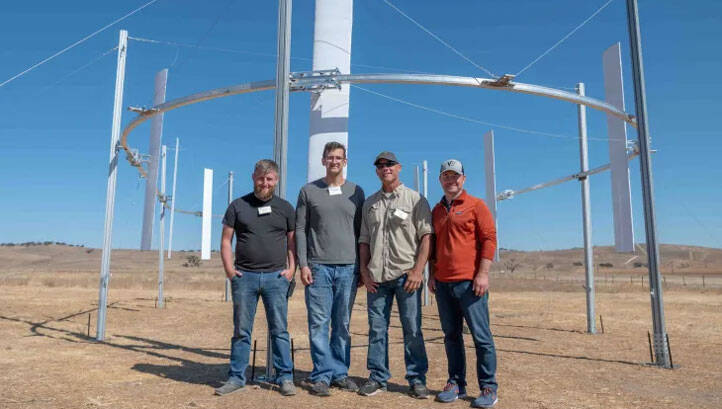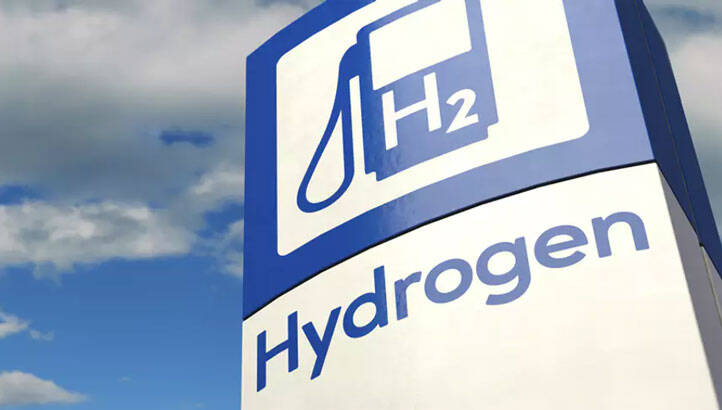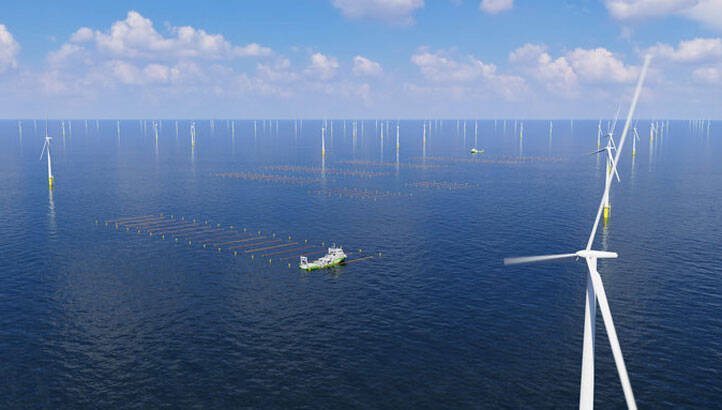Register for free and continue reading
Join our growing army of changemakers and get unlimited access to our premium content

What’s on the horizon for green innovation in the year ahead and beyond? The enormity of the challenges the world faces – from decarbonisation to nature restoration, soil regeneration, and adaptation to extreme weather – make this question pressing and sometimes overwhelming.
This is particularly true for anyone entrusted with developing a sustainability strategy or dealing with mandatory ESG disclosures and new or updated regulations.
A new report from our innovation partner Springwise, Horizon 2030, identifies seven key drivers of positive change for the coming 12 months, and beyond to 2030. Momentum is being fuelled by innovation that has the potential to help organisations meet their emissions targets or execute on their sustainability strategies.
Read our summary of the green innovation themes to watch this year below. The full report is available via the Springwise site; click here.
1) Adapting to extreme weather
Image: SkyCool
In 2023, the world experienced the hottest year on record, and, as climate change ramps up, weather extremes will become the new normal. According to C40, a global network of nearly 100 city mayors, nearly one-third of the world’s population is exposed to life-threatening heat extremes for 20 days of the year or more.
Additionally, flooding has wrought devastation over the past 12 months, with floods in Libya alone killing nearly 11,000 people.
Adapting to the new weather reality will be a key driver of innovation and many of the solutions will be inspired by the Global South. Complexity is added by the need to ensure that efforts to adapt to the effects of climate change don’t add to its causes. Nowhere is this more true than in the case of cooling. Refrigerants and the energy consumption of cooling systems account for around 7% of global greenhouse gas emissions, so simply increasing cooling technologies that exist today is not a meaningful solution.
Solutions like urban greening and the scale-up of ‘traditional’ building techniques for passive cooling are vital, but more hi-tech innovation can also play a role. For example, US-based SkyCool Systems is leveraging a scientific phenomenon called radiative sky cooling to reduce the emissions intensity of air conditioning and refrigeration systems. All objects give off heat in the form of infrared radiation, and this heat is then trapped by the atmosphere. However, radiation given off in wavelengths of between eight and 13 micrometres can escape into space. SkyCool has developed a proprietary material that converts the infrared light leaving a surface into this wavelength range, allowing the heat to escape to the cold sky.
The technology can be applied in panels that are covered in a film that both reflects sunlight and emits infrared radiation. These mechanisms keep the panels, and any cooling fluid running through them, cooler than the surrounding environment with no electrical input, significantly improving the efficiency of cooling systems. The film can be applied separately from the panels to batteries, outdoor shade structures, metal roofs, and refrigerated vehicles.
2) Next-gen solutions to deliver the renewables pledge
Image: AirLoom
At COP28, which concluded in Dubai last month, 130+ national governments endorsed a pledge to triple global renewable energy capacity by 2030. This will require the addition of 11 terawatts of renewable energy capacity by the end of the decade.
Fortunately, renewable electricity is one area where we have well-established, mature technologies following steep cost reductions over the past decade. Despite this, there remains much scope for innovation as we build out a decarbonised grid. Unglamorous but essential innovation in enabling technologies, such as energy storage and power transmission and distribution, will need to continue apace. And further improvements and cost reductions in renewable generation technologies remain a tantalising prize.
Wind energy is one area where this is evident. Over time, turbines have grown bigger, which has created new challenges with public approval and financing. One startup taking a radical new approach, is Bill Gates-backed AirLoom Energy. The company has created a wind energy system that consists of vertically orientated, 10-metre-long wings attached to a lightweight track, rather than massive turbine blades mounted on tall towers. The wings intercept the wind, which propels them along the track, generating power. Supported by 25-metre-tall poles, the oval track can vary in length – from metres to miles – depending on project needs.
This new approach is designed to maximise public acceptance by minimising the visual impact on landscapes and offers significant cost reductions, with an AirLoom wind farm costing 25% less to build than a traditional wind project. This is largely due to material efficiency.
3) Digital net-zero strategising
While mature net-zero solutions exist in electricity generation, other sectors are far harder to abate, including heavy industrials like cement, steel and chemicals.
Innovators are working hard to overhaul the physical processes that underpin industry through solutions such as systems for sequestering captured carbon into concrete and lower-temperature methods for purifying iron ore.
However, data and artificial intelligence also have a role to play by helping those working to decarbonise industry know where to begin, where to focus their efforts, and how to continuously improve efficiency.
UK firm QiO Technologies, for example, aims to transform the ability of industrial companies to achieve carbon neutrality. Based on AI analyses, the startup’s Foresight Sustainability Suite improves production efficiency, tracks the performance of every machine, and provides service and maintenance support. The company provides the three different parts of the Sustainability Suite separately or together, allowing businesses to focus on the areas they most want to improve. Foresight Optima maximises production efficiency. Meanwhile, Foresight Maintenance tracks and predicts machine failures to help reduce operating downtime, and Foresight Service helps businesses better plan the timing and order of fixes and upgrades.
4) Building the green hydrogen ecosystem
Hydrogen is sometimes referred to as a ‘swiss army knife’ for decarbonisation. The versatile element, which can act as a fuel and a feedstock, produces no greenhouse gas emissions at the point of use. It could be particularly important in hard-to-abate sectors such as heavy industry, long-haul transportation, and aviation.
Not all hydrogen is created equal, however, and for hydrogen to be a truly sustainable solution, it needs to be ‘green,’ which means it is produced using electrolysis processes powered by renewables. Today, electrolysers remain relatively expensive, so very little of the world’s commercially produced hydrogen is green, with most produced using fossil fuels. Innovations that bring electrolysers down the cost curve will therefore be increasingly important as we move towards 2030.
There are further challenges associated with hydrogen, and one of these is the difficulty of transporting it given the extremely low temperatures and high pressure needed to keep it stable. Turning hydrogen into ammonia – which is made up of hydrogen and nitrogen from the air – makes it much easier to store and move around. Cambridge University spinout Nium uses nanocatalysis, powered by renewable energy, to make this conversion at significantly reduced temperatures and pressures compared to the Haber-Bosch process – the way that ammonia has been produced for nearly a century. When the ammonia reaches its destination, the decentralised nature of Nium’s system means it is easy to turn it back into hydrogen using the same green process.
5) Nature-based and man-made carbon removal
Image: North Sea Farmers
One of the most important climate-related moments of 2023 was the publication of The IPCC AR6 Synthesis Report. This report states that, when used “in addition to deep, rapid, and sustained emission reductions”, carbon dioxide removal (CDR) can lower net CO2 emissions in the near term, counterbalance residual emissions from hard-to-abate sectors, and achieve net-negative emissions. In short, it has a significant role to play in delivering a Paris-Agreement-aligned world.
CDR options – both natural solutions and mechanical technologies such as direct air capture (DAC)- are being taken increasingly seriously by innovators around the world.
The past year has seen some important policy announcements relating to DAC, particularly in the US, which will spark further innovation to scale up and reduce the cost and energy intensity of this technology.
However, natural solutions remain an essential part of the equation, and the potential of the ocean – the world’s largest carbon sink – is emerging as an area of focus. For example, seaweed is attracting attention as a solution for a wide range of issues. Like land plants, seaweed absorbs atmospheric CO2 through photosynthesis. And while the exact potential of seaweed habitats for sequestering carbon at scale remains uncertain, some experts believe that the fast-growing macroalgae could help to mitigate man-made CO2 emissions.
One project that is set to contribute to our understanding of seaweed-based carbon capture is the North Sea Farm 1 project, which will be the first commercial-scale seaweed farm located between offshore wind turbines. In addition to producing at least 6,000 kilogrammes of fresh seaweed in its first harvest, the project will use funding from Amazon to explore the potential of large-scale seaweed farming for sequestering carbon from the atmosphere. The idea behind the project is that locating seaweed farms between wind turbines could turn previously untapped ocean space into a tool for fighting climate change through carbon capture.
6) Meaningfully closing the loop on waste
Image: Resortecs
The framework for planetary boundaries was first shared in 2009 by a group of 28 internationally renowned scientists. These nine boundaries set out parameters within which humanity can continue to thrive. If we transgress them, however, we risk large-scale, abrupt, or irreversible environmental change. And analysis updated during 2023 shows that we have already breached six out of the nine.
The need to ‘live within our means’ as a species is likely to be a further driver of innovation in 2024 and beyond. This is not only for climate-related reasons but also to do with biodiversity, human impacts and with issues such as supply chain disruptions in mind.
In the past, circular economy advocates spoke of the three ‘Rs’: reduce, reuse, recycle. But such is the scope of the challenge today, that the Rs now need to extend to include ‘regenerate’ – as depleted soils threaten food security – as well as to ‘repairing, reducing, and even refusing’ when it comes to consumer culture.
Fashion has one of the largest environmental footprints of any industry, so transitioning it to a circular model is particularly important. But historically, the cost of recycling clothes has been high due to the need to disassemble garments manually, and a significant amount of the material is lost during the process. This is particularly true for increasingly popular fabric blends including some fossil-based feedstocks.
Now, a Belgium-based startup, Resortecs, is offering retailers automated disassembly at an industrial scale. Its Smart Stitch yarns are made from either bio-based or pre-existing synthetic polymers, are compatible with existing stitching machines, and can be used in a variety of applications, from apparel to workwear.
The yarns have melting points between 150–190 degrees Celsius, so when a garment is discarded it can go through Resortecs’ Smart Disassembly system, a closed-loop heating system that maximises energy recovery and minimises CO2 emissions. The garments go into the system and the Smart Stitch yarn simply ‘melts’ away, leaving up to 90%recoverable fabric.
7) More impactful business-led collaborations
The final key driver of change is the growing appetite business has for meaningful change, with forward-looking organisations leveraging innovators via accelerator programmes or making meaningful contributions to environmental programmes that go beyond greenwashing.
Innovation accelerator programmes edie has reported on in recent months involve businesses beyond your usual suspects in big tech such as Google and Amazon. Click here for all of edie’s innovation-related content.
For a deeper dive into the seven themes above from Springwise’s contributors including experts from Forum for the Future, intelligence firm ICIS, and global summit ChangeNOW, click here to access the Horizon 2030 report.
Springwise is the global innovation platform for leaders looking to drive positive and sustainable change. Its weekly newsletter is a round-up of the most popular innovations and latest features on the site. It’s free to access and you can sign up here.









Please login or Register to leave a comment.